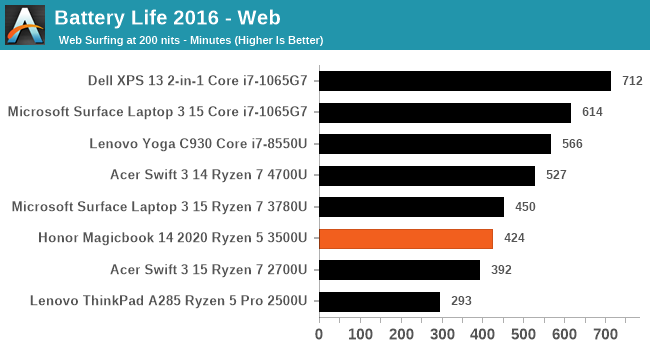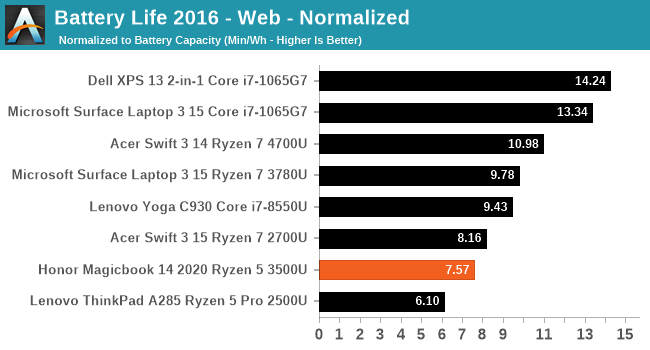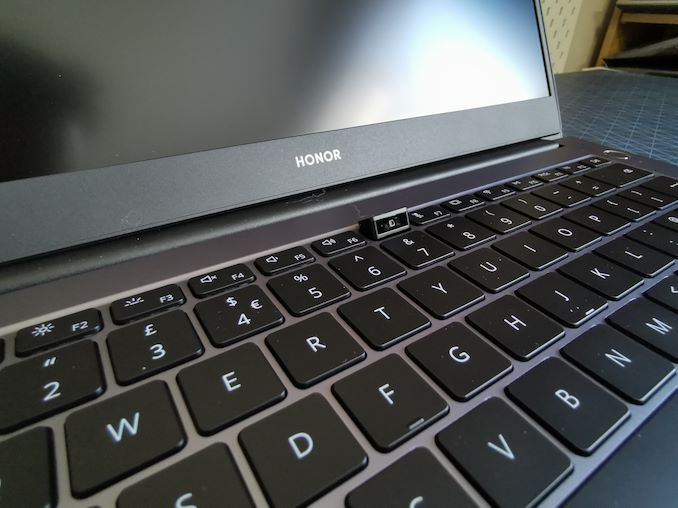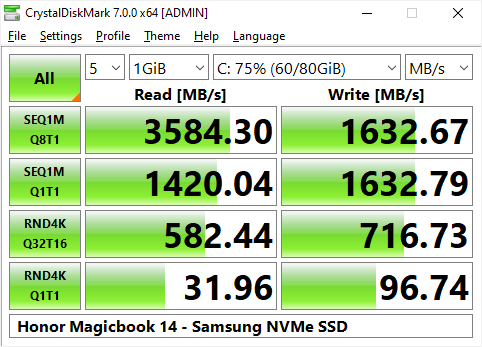Honor Magicbook 14 Notebook Review: Where Style Paints a Picasso
by Dr. Ian Cutress on May 15, 2020 9:00 AM EST- Posted in
- Laptops
- AMD
- Notebooks
- Zen
- honor
- Picasso
- MagicBook
- Magicbook 14
- Ryzen 5 3500U
Battery, Display, and Storage
Battery
One of the key differentiators with AMD’s newer Renoir mobile processor line is the better battery life. The battery life of devices using AMD’s Picasso mobile processors, as used here in the Honor Magicbook, has depended a lot on the implementation as well as the components of the system being used. The OEM has to be able to set up the system to get to idle quickly, and remain there. Nonetheless, the idle power consumption also needs to be low, not only for the CPU, but for the system, which means using efficient LCD panels where possible, and efficient controllers.
Honor claims that the Magicbook 14, with its 56 Wh battery, should be good for 9-10 hours of web/movie/office work, although this value is when the display is at 150 nits using MobileMark2014. For our test, as with our other laptops, we put the display at a more user-friendly 200 nits and run our web-app based light workload.

The Honor Magicbook 14 lasts 7 hours and 4 minutes in our test, or 424 minutes. This puts it ahead of the first gen Ryzen 2000 APUs, but behind the newer Ryzen 4000 APUs. The battery life of the Ryzen 7 in the Microsoft Surface Laptop with the same generation processor is quite near, however as we can see they are all a bit below what the intel systems can provide.

If we normalize for the battery capacity, then we are a bit further behind the AMD-based Surface Laptop than intended, and even behind the Acer Swift 3 with the Ryzen 7 2000 series.
Display
Inside the Honor Magicbook is a 1920x1080 non-touch LCD display, with ~5mm bezels. The webcam for the laptop is not in the display frame, but in a pop-up key between the F6 and F7 keys. Personally I’m not a fan of this webcam, because it means all you get is nose shots when using it on calls. However based on customer feedback, Honor (and Huawei, who use the same idea) says that their customers prefer having one there rather than not having one at all, like on the ASUS Zephyrus G14.
For the display, we measured a peak brightness of 240 nits, which is actually really low. Honor does not list an official brightness for the screen, but we suspect around ~250 nits, and this is perhaps one of the areas that helps bring the cost of the system down to $560. For color accuracy, with the system as shipped, it was not good at all:
After we applied a color calibration tool, the end result was almost ideal:
Storage
One of the highlights on this system is that Honor only have SSD options – not only that, they are Samsung NVMe PCIe 3.0 x4 SSDs. Someone at Honor is smart, and this helps the system in a lot of user responsiveness type scenarios. I had no issues.
The drive is the Samsung MZVLB256HAHQ, which translates as the PM981 with the Phoenix controller and Samsung TLC NAND. The drive is rated at 2.8 GB/s read and 1.1 GB/s write, but we achieved 3.6 GB/s read and 1.6 GB/s write, a substantial gain. This drive over at Amazon is $64, representing more than 10% of the cost of this system.















88 Comments
View All Comments
jabber - Sunday, May 17, 2020 - link
Wow like 99% of computer users in the 21st century..I never use those keys.Or Scroll Lock/Pause/Break/PrtScr and most of the F keys. The C64 had it right with about only 4 of them.
RSAUser - Monday, May 18, 2020 - link
Page up and down you could argue unless you're pretty much anyone who codes or uses spreadsheets or word documents (heck, I even used it on this page to scroll down to these comments).Home and end key you can't, jumping from beginning to end of line is pretty common usage, also allowing you to get back to the top in office documents.
jabber - Monday, May 18, 2020 - link
Never use em!Spunjji - Monday, May 18, 2020 - link
The majority of users use the scroll wheel. In my experience it's basically just coders who use these functions, and most of them are capable of remapping keys to account for the loss.Spunjji - Monday, May 18, 2020 - link
You seem to have missed the part where these deficiencies are assessed against the cost. If you can't afford anything more expensive, then this is a good result for the money.pjc15 - Saturday, May 16, 2020 - link
IMO, you can't heap praise on the design of a laptop that has so many design cues copied from the MacBook Air. It may be "legal" to copy, but it is completely lacking in integrity on the part of Honor. It was mentioned in the article that the chiclet design was copied, but that doesn't even matter. They copied the font on the keys and the shape of the keys, like the arrow keys. It would not surprise me if the cutout on the keyboard housing to lift up the display was a millimeter copy of the MacBook Air. Even internally, it looks very similar.It would be more accurate to say that it looks like a generic clone of a MacBook with some added touches, not that it has a notably good design.
yannigr2 - Sunday, May 17, 2020 - link
Really? We are talking about laptops. Many laptops will share common design choices. What's next? Are we going to call a copy, every laptop that comes with a screen, a keyboard and a touchpad, because, well there where thousands of other models before, also combining a screen, a keyboard and a touchpad?jabber - Sunday, May 17, 2020 - link
Yeah it's like car design. Most are generic. It's only the grille and badge that separate them.bigboxes - Sunday, May 17, 2020 - link
And why does this bother you?Spunjji - Monday, May 18, 2020 - link
The Macbook Air took a bunch of design cues from earlier Sony and Toshiba ultraportables, including the chiclet keyboard. How far do we want to go back?